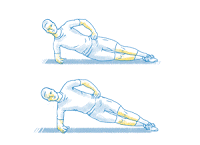Treatment
Success of Hip and Core or Knee Strengthening for Patellofemoral Pain:
Development of Clinical Prediction Rules.
JE, Bolgla LA, Emory C, Hamstra-Wright KL, Tarima S, Ferber R. J Athl Train. 2018. [Epub ahead
of print]
endurance (ability to hold a plank position) may help predict which patients
with patellofemoral pain will improve after a hip/core or knee strengthening
program.
Clinicians can use clinical prediction
rules to identify patients who are likely to respond to a specific rehabilitation
program. Numerous factors (for example, weak hip and knee strength, limited hip
range of motion) may cause patellofemoral pain syndrome, which can make it
challenging for a clinician to select an optimal treatment strategy. No
investigators have included hip or pelvic measurements into a clinical
prediction model for success after rehabilitation program. Therefore, the
authors developed a clinical prediction rule that incorporated clinically
measurable factors (age, sex, weight, hip strength, posterior core endurance,
iliotibial band flexibility) to predict positive outcomes after hip and core or
knee strengthening programs for individuals with patellofemoral pain. The
authors did these analyses using data from a previously discussed trial. One hundred and ninety-nine participants were
randomly assigned to a hip-and-core-focused (111 participants) or knee-focused
(88 participants) rehabilitation. Each group completed a 6-week rehabilitation
program that consisted of 3 sessions/week along with a home exercise program.
Participants reported pain using a 10-cm visual analog scale and the Kujala Anterior Knee Pain Scale to self-report knee function. A successful
rehabilitation was defined as a decrease in visual analog scale by >2
cm or an increase in Anterior Knee Pain Scale by >8 points. Eighty
percent of the hip and core-focused group and 77% of the knee-focused group had
successful outcomes. Participants in both groups who had successful outcomes maintained
their improvements 6 months after rehabilitation. Participants with more pain,
better function, and greater lateral core endurance (side-bridge hold), and
less anterior core endurance (front plank hold) were more likely to have a
successful outcome after hip-and-core-focused program (88% sensitivity and 54%
specificity). Individuals with lower weight, weaker hip internal rotation,
stronger hip extension, and greater trunk-extension endurance were more likely
to have success after knee strengthen program (82% sensitivity and 58%
specificity).
and hip and core strength or endurance may help predict who will improve after strengthening
interventions. Both clinical prediction rules were better at predicting who
would be successful than predicting who would not be successful with a rehabilitation
program. It was interesting to note that there were different predictive
factors per group, which suggests that patients with patellofemoral pain may represent
subgroups with different causes and would require different rehabilitation
programs. These clinical predictive rules could help clinicians individualize
rehabilitation programs to further improve patient care. Medical professionals
should be aware of these clinical factors that may predict which rehabilitation
programs would be most successful; however, implementation of this clinical
production rule should be applied with caution until further validated studies
have been conducted.
patellofemoral pain need to be assessed prior to forming a rehabilitation
program? Do you incorporate hip and core exercises into your patellofemoral
rehabilitation programs?


